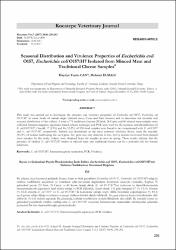| dc.contributor.author | Can, Hayriye Yeşim | |
| dc.contributor.author | Elmalı, Mehmet | |
| dc.date.accessioned | 2019-01-29T06:57:14Z | |
| dc.date.available | 2019-01-29T06:57:14Z | |
| dc.date.issued | 2017 | |
| dc.identifier.uri | http://dergipark.gov.tr/download/article-file/397979 | |
| dc.identifier.uri | http://hdl.handle.net/11630/5260 | |
| dc.description.abstract | Bu çalışma, bazı hayvansal gıdalarda (kıyma, Carra ve Surk peynirleri) Escherichia coli O157, Escherichia coli O157:H7varlığı ile virülens özelliklerini araştırmak ve izolatların aylık-mevsimsel dağılımlarını belirlemek amacıyla yürütüldü. Toplam 71 geleneksel peynir (35 Surk, 36 Carra) ve 60 kıyma örneği alındı. E. coli O157:H7'nin izolasyon ve identifikasyonunda immunomanyetik separasyon bazlı kültür tekniği ve PCR kullanıldı. Genel olarak, 131 gıda örneğinin 17 (% 13) ve 16'sının (% 12.2) sırasıyla E. coli O157 ve E. coli O157:H7 ile kontamine olduğu tespit edildi. İzolatların çoğunluğunun (% 83.3) eaeA genine sahip olduğu ve intimin en yaygın virülens faktörü olarak belirlendi. Stx2 geni yalnızca kıyma örneklerinden elde edilen iki (% 6.6) izolatta saptandı. Bu çalışmada, izolatlar örneklerden en fazla ilkbaharda elde edildi. Bu sonuçlar kıyma ve geleneksel peynirlerde virülens özelliği olan E. coli O157:H7 suşlarının bulunmasının insanlardaki infeksiyonlar açısından potansiyel bir risk oluşturabileceğini göstermektedir. | en_US |
| dc.description.abstract | This study was carried out to investigate the presence and virulence properties of Escherichia coli O157, Escherichia coli O157:H7 in some foods of animal origin (minced meat, Carra and Surk cheeses) and to determine the monthly and seasonal distribution of the isolates. A total of 71 traditional cheeses (35 Surk, 36 Carra) and 60 minced meat samples were collected. Immunomagnetic separation based cultural technique and PCR were used for the isolation and identification of E. coli O157:H7. Overall, 17 (13%) and 16 (12.2%) of 131 food samples were found to be contaminated with E. coli O157 and E. coli O157:H7, respectively. Intimin was determined as the most common virulence factor, since the majority (83.3%) of isolates harbouring the eaeA gene. Stx2 gene was only detected in two (6.6%) isolates recovered from minced meat samples. In this study, isolates were obtained from the samples at most in spring. These results indicate that the presence of virulent E. coli O157:H7 strains in minced meat and traditional cheeses can be a potential risk for human infections. | |
| dc.language.iso | eng | en_US |
| dc.identifier.doi | 10.5578/kvj.61809 | en_US |
| dc.rights | info:eu-repo/semantics/openAccess | en_US |
| dc.subject | E. coli O157:H7 | |
| dc.subject | Immunomagnetic Separation | |
| dc.subject | PCR | |
| dc.subject | Virulence | |
| dc.subject | Immunomagnetic separation | |
| dc.subject | Virülens. | |
| dc.subject | İmmunomanyetik separasyon | |
| dc.title | Kıyma ve geleneksel peynir örneklerinden izole edilen escherichia coli o157, escherichia coli o157:h7’nin virülens özellikleri ve mevsimsel dağılımı | en_US |
| dc.title.alternative | Seasonal distribution and virulence properties of escherichia coli o157, escherichia coli o157:h7 ısolated from minced meat and traditional cheese samples | en_US |
| dc.type | article | en_US |
| dc.relation.journal | Kocatepe Veteriner Dergisi | en_US |
| dc.department | Mustafa Kemal Üniversitesi, Veteriner Fakültesi | en_US |
| dc.identifier.volume | 10 | en_US |
| dc.identifier.startpage | 256 | en_US |
| dc.identifier.endpage | 263 | en_US |
| dc.identifier.issue | 4 | en_US |
| dc.relation.publicationcategory | Makale - Ulusal Hakemli Dergi - Kurum Yayını | en_US |



















